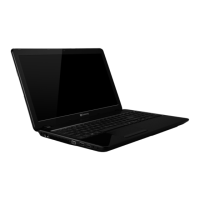
Do you have a question about the Gateway NV52L and is the answer not in the manual?
Connect your computer to a wireless network. Instructions for enabling Wi-Fi and connecting.
Recommended steps to register your Gateway product for service and news.
Information on the automatic software installation process.
Guidance on creating recovery discs using Gateway Recovery Management.
Options for customer support, including Gateway support and website.
Details on warranty and how to contact technical support.
Guidelines for comfortable computer use and avoiding health problems.
Specific environmental and usage precautions for the computer.
Ensure cables are not strained and protected from damage.
Instructions for safely cleaning the computer using a damp cloth.
Advice on when to seek qualified service personnel for repairs.
Identifies webcam, display screen, and microphone on the top view.
Identifies power button, keyboard, and touchpad on the top view.
Explains the function of special keys and hotkeys on the keyboard.
Identifies the multi-in-1 card reader on the front view.
Identifies DC-in jack, Ethernet, VGA, HDMI, and USB ports on the left view.
Identifies USB ports, optical drive, and eject features on the right view.
Identifies battery bay, memory compartment, and hard disk bay on the base.
Explains how the touchpad controls the cursor and basic gestures.
Details multi-finger gestures for navigation and control within Windows 8.
Discusses computer expansion options and connectivity.
Details how to connect peripheral devices via ports like USB, Ethernet, etc.
Information on using the external power adapter and its caution.
Details on battery characteristics, charging, and maximizing its life.
Step-by-step process for conditioning a new battery pack.
Strategies to conserve power, including disabling fast startup.
Overview of pre-installed software and programs.
Details on the included internet security suite and its benefits.
Guidance on creating recovery backups for system recovery options.
Initial steps for connecting to the internet and protecting your computer.
Vital steps to protect against viruses and online attacks.
How to select an Internet Service Provider (ISP) for connectivity.
Explains different ways to connect to the internet: Dial-up, DSL, Cable, 3G.
Information on setting up LAN and wireless networks (Wi-Fi, Bluetooth).
Benefits and components of setting up a wireless LAN at home.
Importance of online security and using pre-installed security software.
Steps to create a factory default backup on a USB drive.
How to create a backup of drivers and applications on DVD or USB.
Methods to recover your system, including reinstalling drivers and reverting to a previous state.
How to reinstall factory-provided software and drivers.
Using System Restore to return to a previous system state.
Steps to reset the PC to factory settings, either removing files or cleaning the drive.
How to recover your system using a recovery backup from a USB drive.
Troubleshooting steps for power and boot-up issues.
Solutions for a blank screen, often related to power saving settings.
Troubleshooting steps for audio issues, including volume and mute settings.
Troubleshooting steps if the keyboard is not working.
Basic concepts and navigation tips for Windows 8.
Instructions on accessing the Windows 8 charms bar.
Methods to access the Start screen or menu in Windows 8.
Steps to unlock the computer, including password entry.
Customizing the Start screen background and tile layout.
Steps to check for and install Windows updates.
Caution regarding permanent hearing loss from prolonged high-volume use.
Warning about chemicals known to cause cancer or reproductive harm.
Regulatory information for wireless adapters.
FCC and FAA standards for human exposure to RF energy.
FCC RF exposure limits and antenna placement guidelines.
Restrictions on wireless LAN usage based on country and frequency bands.
Information on country-specific regulations for device usage.
French regulations for 2.4 GHz WLAN and 5 GHz 802.11a usage.
Italian regulations for equipment usage based on DL.gs 1.8.2003 and D.M. 28.5.03.
Belgian regulations regarding registration for private use depending on distance.